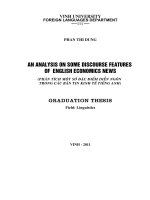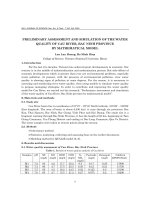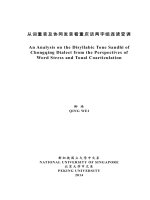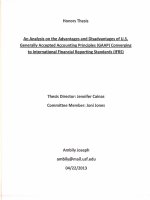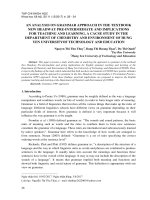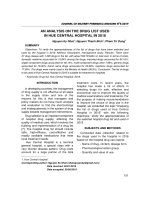AN ANALYSIS ON THE WORK ENGAGEMENT OF VIETNAMESE MIDDLE MANAGERS THE CASE OF FDI ENTERPRISES BAC NINH PROVINCE
Bạn đang xem bản rút gọn của tài liệu. Xem và tải ngay bản đầy đủ của tài liệu tại đây (972.94 KB, 112 trang )
MISTRY OF EDUCATION AND TRAINING
FOREIGN TRADE UNIVERSITY
MASTER THESIS
AN ANALYSIS ON THE WORK ENGAGEMENT OF
VIETNAMESE MIDDLE MANAGERS: THE CASE
OF FDI ENTERPRISES - BAC NINH PROVINCE
Specialization: Master of Research in International Economics
NGUYEN DIEU LINH
Ha Noi, 2020
i
MINISTRY OF EDUCATION AND TRAINING
FOREIGN TRADE UNIVERSITY
MASTER THESIS
AN ANALYSIS ON THE WORK ENGAGEMENT OF
VIETNAMESE MIDDLE MANAGERS: THE CASE
OF FDI ENTERPRISES - BAC NINH PROVINCE
Major: International Economics
Specialization: Master of Research in International Economics
Code: 8310106
Full name: Nguyen Dieu Linh
Supervisor: Dr. Nguyen Hai Ninh
Ha Noi, 2020
DECLARATION
I hereby declare that the master thesis is my own research. It was written
with the thorough guidance of my supervisor – Dr. Nguyen Hai Ninh
……
Hanoi, May,22 May 2020
Author
Nguyen Dieu Linh
ACKNOWLEDGEMENT
The master thesis has been completed with the great guidance of Dr. Nguyen
Hai Ninh. I would like to express my sincere thanks for his patience and massive
help with reading the whole of the thesis and making valuable comments for my
research.
By this occasion, I am much grateful to the Department of Graduate Studies
and Foreign Trade University - who have always create most favorable conditions
for Morie 2 students in completing our study. Thank you so much for their
generosity and I owe a debt of gratitude to all helpers.
TABLE OF CONTENTS
LIST OF ABBREVIATIONS................................................................................ vi
LIST OF FIGURES.............................................................................................. vii
LIST OF TABLES................................................................................................ viii
CHAPTER 1 INTRODUCTION............................................................................ 1
1.1. Emergence of study........................................................................................1
1.2 Purpose of study.............................................................................................. 2
1.3. Subject and scope of the study....................................................................... 3
1.4. Research methodology and research questions............................................. 4
1.5. Structure of thesis.......................................................................................... 5
CHAPTER 2 THEORETICAL FRAMEWORK..................................................6
2.1. Theoretical famework...................................................................................6
2.1.1. Literature review....................................................................................... 6
2.1.2 Classification of work engagement......................................................... 14
2.1.3 The importance of work engagement on FDI enterprises...................... 15
2.1.4 Factors influence employees’ work engagement..................................... 17
2.1.5 Previous researches of work engagement............................................... 17
2.2. Snapshot of FDI enterprises - Bac Ninh province..................................... 24
2.2.1 FDI enterprises in Vietnam..................................................................... 24
2.2.2. The whole picture of FDI enterprises in Bac Ninh................................ 25
CHAPTER 3 RESEARCH METHODOLOGY.................................................. 35
3.1. Research design and procedure................................................................... 35
3.2. Suggested research model and hypotheses.................................................. 36
3.3. Research methodology................................................................................. 37
3.3.1. Questionnaire design:............................................................................... 38
3.4. Sampling method......................................................................................... 42
3.5. Data collection method................................................................................ 43
3.6. Data analysis process................................................................................... 44
CHAPTER 4 MAIN FINDINGS..........................................................................47
4.1. Demographical Analysis.............................................................................. 47
4.2. Assessing work engagement level of Vietnamese middle level managers in
FDI enterprises - Bac Ninh province
49
4.3. Factors affecting work engagement of Vietnamese middle level managers
in FDI enterprises - Bac Ninh
50
4.3.1. Reliability test (CR).................................................................................50
4.3.2. Exploratory Factor Analysis (EFA).......................................................... 51
4.3.3. Multiple regression analysis...................................................................... 57
4.3.4. ANOVA test................................................................................................ 61
4.3.5. Hypothesis test result................................................................................. 66
CHAPTER 5 RECOMMENDATIONS...............................................................68
5.1. Conclusions and answering the research questions.................................... 68
5.2. Recommendations........................................................................................ 70
REFERENCE........................................................................................................ 80
APPENDIX 01: SURVEY FORM FOR MIDDLE MANAGERS AT FDI
ENTERPRISES IN BAC NINH................................................................................ 86
APPENDIX 02: LIST OF FDI ENTERPRISES IN BAC NINH........................93
APPENDIX 03: REGRESSION ANALYSIS....................................................... 95
APPENDIX 04: RELIABILITY TEST RESULT............................................... 96
APPENDIX 05: T- TEST RESULTS.................................................................. 100
LIST OF ABBREVIATIONS
No
Acronym
Explanation
1
FDI
Foreign Development Investment
2
GDP
Gross Domestic Product
3
NWW
New Way of Working
4
KPI
Key Performance Indicator
LIST OF FIGURES
Figure 2.1: Effectors creating employees’ satisfaction............................................18
Figure 2.2: Utrecht Work Engagement Scale (UWES)............................................19
Figure 2.3: Model of Torp et al. (2012) about work engagement............................20
Figure 2.4: Model of work engagement Stan et al...................................................21
Figure 2.5: Relationship of Structural Determinants and Organizational
Commitment/Job Satisfaction..................................................................................23
Figure 2.6: Hierarchical view of management in organizations...............................31
Figure 2.7: Middle management roles.....................................................................34
Figure 2.8: Vietnam's FDI total capital registered and average capital per project 24
Figure 3.1 Research design and procedure..............................................................35
Figure 3.2: Suggested research model.....................................................................36
Figure 3.3. The 5- point Likert scale........................................................................42
LIST OF TABLES
Table 3.1 Available options for demographic questions in Section A.....................39
Table 3.2. Measurement of Current Job/ Task........................................................40
Table 3.3 Measurement of Working Conditions......................................................40
Table 3.4 Measurement of Salary and Income........................................................40
Table 3.5. Measurement of Leadership....................................................................41
Table 3.6. Measurement of Colleagues....................................................................41
Table 3.7 Measurement of Training and Promotion.................................................41
Table 3.8 Measurement of Organizational Structure................................................42
Table 3.9. Measurement of Work Engagement........................................................42
Table 4.1. Mean of variables....................................................................................49
Table 4.2 Reliability Statistics Summary.................................................................50
Table 4.4 Model summary.......................................................................................57
Table 4.5 ANOVA...................................................................................................57
ABSTRACT
This master examines the factors that influence and shape employee
engagement in the context of FDI enterprises in Bac Ninh province. It does this by
studying multilevel factors at two values: Spiritual values and Physical values.
Specifically, the thesis focuses on seven independent factors affecting work
engagement of employees.
To achieve this objective, this study adopted a mixed-method approach including:
Quantitative and Literature review.
For quantitative method, the study employed the quantitative method to
determine the relationship between work engagement and seven independent
variables, as well as the relationship between work engagement and each
demographic factor. After being collected, survey results were analyzed by the
Statistical Package for the Social Sciences (SPSS) Version 26. By conducting a
comprehensive survey with a sample size of 144 middle-level managers at 4 largest
industrial zones in Bac Ninh, a number of tests were performed
on
the
collected data, namely Kaiser -Meyer-Olkin (KMO) Measure of Sampling
Adequacy, Bartlett’s test of sphericity, Cronbach’s alpha reliability test, Exploratory
Factor Analysis, Multiple regression analysis and One -way ANOVA test. In terms
of Literature review, by reviewing previous researches to analyze core meanings
and principal of work engagement, therefore we can identify main effectors
affecting employees work engagement.
The thesis aims to measure work engagement and look at the areas where
management interventions can be implemented to increase the overall level of
employee engagement drafting several solution and recommendation for locality in
Bac Ninh to attract and maintain more high qualified middle managers within FDI
enterprises.
1
CHAPTER 1
INTRODUCTION
1.1. Emergence of study
Work engagement is a common concept, both in the business context and in
the academy. This term first appeared in the 1990s and meanwhile, more than 200
scientific publications have appeared on this topic. According to a global survey of
CEOs, attracting employees is one of the five most important challenges for
organizations. Consequently, international business consulting firms
have
developed their own proprietary concepts and survey tools. Based on large
international databases, covering many different industries, these companies
estimate that only about 20% of all employees are involved in their jobs, while
another 20% be relaxed and about 60% participate in moderation. These consulting
companies also state that employee engagement promotes business success
(Schaufeli) 2012. It is concluded that work engagement is a feasible concept for
both science and practice and it needs to be paid more attention and applied to the
operational practices of businesses.
FDI inflows are a very important driving force for Vietnam's economic
development and have a large contribution to Vietnam's GDP growth. In particular,
Bac Ninh province with good FDI attraction and one of the localities with the most
FDI enterprises in the country.
With the advantage of being located in the Northern key economic region, in
recent years, Bac Ninh province has become a destination for many foreign
investors with more than 1,000 foreign direct investment (FDI) projects. By the end
of June 2029, the total registered foreign investment capital in Bac Ninh province
reached nearly 17 billion USD (Nhandan), 2019.
On the other hand, in these enterprises, the middle management staff is
mainly Vietnamese and plays a backbone for the activities of FDI enterprises. The
work engagement of these managers to businesses is one of the important
development drivers of enterprises in general and FDI enterprises in Bac Ninh in
particular.
According to Gallup Report (2019), companies with a team attached to the
job will increase the competitive advantage by 202%. Therefore, the research topic:
"An analysis on the work engagement of Vietnamese middle managers: the case of
FDI enterprises - Bac Ninh province" is very urgent and suitable with practical
needs in order to offer advanced solutions for work engagement of management at
FDI enterprises in Vietnam (SKHDT BN), 2019.
Thus, in theory, work engagement in human resource management is also a
very important term and is mentioned by many domestic and foreign studies. In
terms of Vietnam's economy, FDI enterprises are the main development drivers and
Bac Ninh province is the most typical province in terms of FDI attraction as well as
reasonable support mechanisms for FDI enterprises. On the enterprise level, middle
managers are the core force and the bridge between Vietnamese workers and
foreign leaders. Therefore, their work engagement determines the performance of
FDI enterprises. For these reasons, the author chooses the topic: "AN ANALYSIS
ON
THE
WORK
ENGAGEMENT
OF
VIETNAMESE
MIDDLE
MANAGERS: THE CASE OF FDI ENTERPRISES - BAC NINH
PROVINCE" to study with great urgency for Bac Ninh in general and is lessons
learned for FDI enterprises throughout Vietnam.
1.2 Purpose of study
The research analyzes on the work engagement of Vietnamese middle managers in
case of FDI enterprises in Bac Ninh province.
In particular, the research hopes to achieve the following main purposes:
- Understanding the situation of work engagement of middle managers in
FDI enterprises in Bac Ninh industrial zones
- Assessing the level of work engagement of middle managers in FDI
enterprises – Bac Ninh industrial zones.
- Exploring the main factors affecting work engagement
- Analyzing the degree of impact of factors on work engagement, especially
in the case of middle managers in FDI enterprises.
- Drafting recommendations to improve the level work engagement of
middle managers in FDI enterprises.
1.3. Subject and scope of the study
1.3.1: Research object and research subject of study
-
Research subject: Work engagement.
-
Research object: Vietnamese middle managers in FDI enterprises - Bac Ninh
province
1.3.2. Scope of Study
Research locations:
The study will be conducted only in 4 large industrial zones in Bac Ninh
including VSIP, Yen Phong, Tien Son and Que Vo as these areas have collected the
required number of samples
Although there are 15 centralized industrial zones with total area of 7,681ha
(6,847ha for industrial zones and 834ha for urban quarters), the study will be
conducted only in 4 large industrial zones in Bac Ninh including VSIP, Yen
PhongTien Son and Que Vo Ten because these industrial zones are the largest zones
about both scale and area compared others. The FDI largest companies are
operating here including Suntory PepsiCo Vietnam Beverages, Fusan Technology
Co., Ltd. (formerly Microsoft phone factory), Canon Vietnam Co., Ltd., Samsung
Electronics Co., Ltd. Vietnam, TOYO INK Compound Vietnam Co., Ltd (TICV),
Sumitomo Electric Interconnect Products Vietnam and many other famous
enterprises in the world with the largest number of workers and Vietnamese middle
managers.
Research period:
The time for researching, interviewing and collecting data from middle
managers in the above mentioned industrial parks will take place from March to
May 2020 including a face-to-face meeting and gathering times. Additional
information, filling out the questionnaire will be done by email
The research analyzes on the work engagement of Vietnamese middle
managers in case of FDI enterprises in Bac Ninh province.
1.4. Research methodology and research questions
1.4.1 Research methodology
To solve the problems raised, the study used a combination of two methods
including: Quantitative and Literature reviews as follows:
Quantitative method: This study employed the quantitative method to
determine the relationship between work engagement and seven independent
variables, as well as the relationship between work engagement and each
demographic factor. After being collected, survey results were analyzed by the
Statistical Package for the Social Sciences (SPSS) Version 26.
By conducting a comprehensive survey with a sample size of 144 middlelevel managers at 4 largest industrial zones in Bac Ninh, a number of tests were
performed on the collected data, namely Kaiser -Meyer-Olkin (KMO) Measure
of Sampling Adequacy, Bartlett’s test of sphericity, Cronbach’s alpha reliability
test, Exploratory Factor Analysis, Multiple regression analysis and One -way
ANOVA test.
Literature review: Reviewing previous researches to analyze core meanings
and principal of work engagement, therefore we can identify main effectors
affecting employees work engagement.
1.4.2 Research questions
Based on these objectives, the research questions were proposed as follows:
1) How is situation of work engagement of middle management in FDI
enterprises in Bac Ninh industrial zones?
2) Which level of work engagement of middle managers is in FDI enterprises
in Bac Ninh industrial zones?
3) Which are the main factors affecting work engagement?
4) How factors affect work engagement, especially in the case of middle
managers in FDI enterprises?
5) What are recommendations to improve the level work engagement of middle
management in FDI enterprises?
1.5. Structure of thesis
Chapter 1: Introduction
Chapter 2: Frame work of work engagement
Chapter 3: Research methods
Chapter 4: Research conclusion
Chapter 5: Recommendations
CHAPTER 2
THEORETICAL FRAMEWORK
2.1. Theoretical framework
2.1.1 Literature review
There are many definitions of work engagement for businesses in the field of
human resource management. From 2000 to the present, the number of research,
publications and articles related to the participation of the work, or the engagement
of employees has skyrocketed both in quantity and quality. From the first academic
paper on workplace engagement published by William Kahn (1990) in the
Management Academy Magazine, the changes in the world of work, the positive
psychological movement was announced and published by a group of academics
working with Martin Seligman, then president of the American Psychological
Association, that promoted the development of "work engagement " issues.
Engagement refers to participation, commitment, passion, enthusiasm,
uptake, focused effort and energy. Work engagement first appears in business,
despite its roots terminology is not entirely clear, it was first used in the 1990s by
Gallup Foundation (1990)
According to Maslach and Leiter (1997) work engagement is basically
formed in aspects including emotional attachment to the organization and
commitment to continued (i.e. desire to stay with the organization) and off-role
behaviors (i.e. arbitrary behavior that promotes the effective functioning of the
organization). Conceptually in this way, employee engagement constitutes a mix of
the two existing psychological concepts. As a result, it seems most consulting firms
are bringing new entrants into the old commitment and bottle the complementary
role. The employees involved have put a lot of effort into the work because they
sympathize with it. Engagement is also said to produce positive results, both at the
individual level (personal growth and development) as well as the organizational
level (quality of performance). In contrast to those who are exhausted, the
employees involved consciously connect energy and efficiency with their work;
instead of stress and demanding they see their work as challenging. Accordingly,
engagement is characterized by energy, participation and efficiency, forming the
direct opposites of three dimensions of exhaustion - exhaustion, cynicism and
reduced achievement. In this view, engagement and exhaustion are inherently
linked and can therefore be assessed by the same method. In addition, engagement
is considered to be an independent, distinct concept that is negatively related to
burnout. It is defined in its true sense as a group of positive, fulfilling, work-related
states, characterized by vitality, dedication and absorption. Work engagement is
characterized by a high level of energy and resilience while working, a willingness
to invest effort in another job, and perseverance even when it is difficult.
Consciousness refers to being strongly involved in one's work, and experiencing
feelings of meaning, enthusiasm, inspiration, pride and challenge. Finally,
absorption is characterized by complete concentration and happiness immersed in
one's work, through which time passes quickly and hard with separation from work
as Schaufeli (2012).
Kahn (1990) argues that employees who engage in work will devote their
entire mind, knowledge, and physical ability to the task, but this definition may be
confused with other factors such as organizational behavior or satisfied / dissatisfied
at work. In order to better understand the different levels of individuals attached to
their roles, Kahn (1990) examined a number of principles. The terms Kahn (1990)
use to describe these calibrations are 'personal participation' and 'personal
disengagement', which refer to the behaviors of people they include or ignore
individual roles while performing their job roles. These terms developed by Kahn
(1990) integrate previous ideas taken from motivational theories that people need to
express and self-control in work life is obvious.
According to Britt (1999; 2003), the definition of work coherence is personal
responsibility and a commitment to fulfill and focus on getting work done.
Maslach and Leiter (1997) assume that work engagement is the complete
opposite of exhaustion, so work cohesion includes: energy, commitment, and
personal achievement. Schaufeli et al (2002) in their new research model suggest
that work cohesion is defined as a state of persistence, positivity, and motivation for
accomplishment. Ulrich (2007) values employees' contribution in business because
when businesses try to create more outputs, businesses have to find ways to engage
employees both mentally and mentally to increase labor productivity.
Various definitions of job linkage are also provided in study of Macey and
Schneider (2008). Accordingly, work engagement is the energy level of a user to
work effectively and efficiently. However, according to Schaufeli and Bakker
(2004), work engagement is considered as a state of oscillation in themself,
employees who are attached to the job, but who may have holidays and nonemployment status are the same for all days. It is important for organizations to
recognize employees who are truly psychologically connected at work (employees
who are truly engaged with the job) because they are always ready and able to
devote themselves to the mind. In their role, these employees are very motivated
and always work towards high quality work standards Bakker & Leiter (2010).
Work engagement is defined as a positive, satisfying, work-related mental
state characterized by attributes of dedication and enthusiasm Schaufeli and Bakker,
(2010). Accordingly, different from the concept of "employee engagement" in the
direction of engagement with the organization, work engagement involves the
mental states expressed in the verbal thinking and actions of employees to work: as
devoted to work, focused on work, passionate about work, worked hard and
energetic. The cohesion mentioned in this concept refers to the state of awareness
and continuity of action and does not focus on any object, individual or event or
behavior. Bakker (2009) gives three factors that measure work cohesion: energetic:
energetic and willing to work hard even when facing difficulties; dedicating factors:
devoting your mind to work, feeling work with enthusiasm, always being inspired,
proud of the job; Passion factor: be completely focused on your work and happy to
spend all your time at work.
Although the aforementioned sample may feel tired after a long day at work,
they consider it a pleasant state, which is well worth the positive results at work.
Employees who are attached to work are not workaholics, they also enjoy other
activities of life outside of work, so for those who are engaged with work, working
is joyful (Gorgievski, Bakker & Schaufeli, 2010).
2.1.1.1 Vietnamese studies on employees work engagement
-
In Vietnam, research of Pham Duy Khanh and Tran Dinh Long
(2015) studied factors affecting employee's engagement with businesses
at Military Petroleum Corporation. The research model in the article uses
Cronbach’s Alpha reliability assessment method and EFA discovery
factor analysis used to screen out the factors that meet the requirements.
The results of the regression model estimation show that "Employee
evaluation",
"Job
identification",
"Training,
remuneration
and
compensation", "Recruitment" are important factors that have a positive
impact on the engagement of employee with businesses.
-
Ha Nam Khanh Giao and Nguyen Dang Huyen Tran (2017) in “
Industry and Trade Magazine” studied the factors affecting employee
engagement with Ho Chi Minh Banking University, by surveying 174
employees using Cronbachs alpha, EFA and multiple regression analysis.
The results showed a model of 05 factors that have a positive impact on
employee engagement, in descending order: Nature of work, Colleague
relations, School reputation, Salaries and benefits, the support from the
superior. On that basis, the author proposes administrative solutions to
the board of directors and the heads of units to increase employee
engagement.
-
The study "Assessing organizational awareness and job satisfaction in
the Vietnamese context" by Tran Kim Dung and Abraham (2005)
explored the relationship between job satisfaction and sense of
attachment. Based on a research sample of 396 full-time employees in Ho
Chi Minh City, the author used a network model, through 3 components
of consciousness associated with the organization and 5 aspects of public
satisfaction. Research shows that employees work hard and are proud of
their workplace because they like the job and have a good relationship at
work.
-
In addition, many domestic authors have studied the factors that affect
employee's long-term engagement with all types of businesses. In the
field of services, author Nguyen Chi Cong (2011) with the study
"Solutions to create long-term cohesion of employees with enterprises in
VNPT member units", used the explore factor analysis method EFA and
multivariate regression analysis to analyze factors that affects employee
engagement. The results of the analysis show that significant positive
impact factors on employee long-term engagement include
job
satisfaction and family influence. At the same time, the author also
pointed out that there is a difference in the intention of long-term
association with businesses between different education and income
groups. Among those with higher education and postgraduate, the level of
engagement with businesses in terms of intention is lower than those with
lower education. And those with an income of five million or more have
a higher degree of engagement with businesses than those with lower
incomes.
-
Tran Van Tuan, (2018) applied the scale of reward and recognition,
organizational
fairness,
organizational
support
awareness,
job
characteristics, work engagement and organizational citizenship M.
(2006) in real life conditions at some Non-life Insurance Companies in
Ho Chi Minh City. Qualitative research was conducted by the author to
adjust and supplement the theory and research scale. Quantitative
research conducted with a sample of 283 employees with 1 year of
working experience or more working full-time in Ho Chi Minh City.
Analysis results show that Organizational Justice In terms of work
engagement, the Rewards and Recognition factors are considered as two
separate factors with different levels of impact on work engagement.
2.1.1.2 . Foreigner studies on employees work engagement
-
The research of Hersey & Blanchard (2001), “The Labor Relations
Institutes of New York” built for the first time applied to workers in
the industry, with 9 encouraging components for employees,
including:
Autonomy at work: The employee has control and responsibility for
his work, is encouraged to participate in work-related decisions and is
encouraged to take initiatives.
Interesting work: Expressing through the diversity, creativity and
challenges of the job and the opportunity to use the individual's
abilities.
Fully recognized work done: Recognized when completing the work
well, as well as contributing to the success of the company.
High salary: Receive a salary that is commensurate with the results of
work and ensures a sufficient personal life
Long-term work: Having a stable job, no need to worry about how to
keep a job or look for new jobs.
Good working conditions: Related issues such as labor safety,
hygiene, environment, working time, etc. are above average in the
industry.
Career advancement and development: Individuals always have
opportunities for advancement and development in the organization.
Support from superiors: The superiors always show their care and
support in solving labor problems.
-
According to Vishwanath V. Baba and Muahammad Jamal (1979)
with the topic "On Becker's Theory of Commitment: An Empirical
Verification among Blue-Collar Workers", through a survey of 377
production workers in 6 companies in the city. Vancouver, the author
has pointed out that the three factors that influence workers'
engagement with the organization are (1) Demographics, (2)
Background, and (3) Job factors. In which, job factors include: variety
of jobs; relaxing time; the help of colleagues; the convenience of
going to the office, which is considered the main factors determining
the work engagement and attitude of employees to the organization
and the work.
-
W. D. Kahn (1990) with study “Psychological Conditions of
Personal Engagement and Disengagement at Work”, is credited with
conceptualizing the major components of employee engagement. His
model proposes that engagement differs from basic job involvement,
in that it focuses not on worker skills but, rather, on how one commits
him/herself during the performance of the
job. Engagement entails
the active use of emotions in addition to the simple use of cognition
while completing work tasks. The major propositions of the model are
that
people
express
themselves
cognitively,
physically,
and
emotionally while performing their work roles. The model proposes
that, in order for individuals to fully engage with their job, three
psychological conditions must be met in the work environment:
meaningfulness safety, and availability
-
The study of Coffman and Gonzalez-Molina (2002), “ How the
world’s greatest organizations drive growth by unleashing human
potential” Employee engagement is also something that
is
changeable, and can vary widely from one workplace to another
Studies indicate that workers are, to some extent, a reflection of the
administrators of an agency. Low or conversely high engagement
scores have been traced back to the organization’s leadership, from
top to bottom. Therefore, the results of engagement studies should
have considerable applicability to the social work field. For instance,
leaders in human service agencies could
utilize
data
from
engagement studies to create and implement strategies that would
increase staff engagement
-
The study of May, Gilson, and Harter (2004), “The psychological
conditions of meaningfulness, safety and availability and the
engagement of the human spirit at work” conducted a field study in a
large Midwestern insurance agency. Using a survey format th ey
explored why some individuals fully engage in their work while
others become alienated or completely disengaged. Results of this
study confirmed that engagement differs from simple job satisfaction.
They agreed that engagement actually entails th e active use of
emotions and behaviors in addition to cognitions. Overall, study
results supported Kahn’s earlier work in that psychological
meaningfulness and safety were positively linked to employee
investment in work roles. Additionally, job enrichment and role fit
were positively related to psychological meaningfulness. Having a
supportive supervisor and good relations with co-workers were related
to feelings of psychological sa fety on the job.
-
Harter, Schmidt, and Hayes (2002), “Business-unit-level employee
satisfaction, employee engagement, and business outcome analysis”
completed a meta-analysis of prior studies on employee engagement
that were conducted by the Gallup Organization. The researchers
examined
the
relationship
between
employee
satisfaction-
engagement, and the business-unit outcomes of customer satisfaction,
productivity, profit, employee turnover, and accidents. Harter et al.
(2002) noted that one of the defining elements of employee
engagement is the actionable quality of the measured concepts. In
other words, employee engagement is related to meaningful business
outcomes and many of the core issues of engagement are ones over
which managers can have substantial influence. High levels of
satisfaction and employee engagement were positively correlated with
customer satisfaction, profitability, productivity, and safety outcomes.
-
A study of Schaufeli, Bakker, and Salanova (2006), “The
measurement of engagement with a short questionnaire: A crossnational study” surveyed 14,521 employees in various occupations,
using a self-report questionnaire that measured work engagement. The
researchers found that engagement is not only the opposite of burnout
but that it has its own characteristics, which were labeled vigor,
dedication,
and
absorption.
The
researchers
concluded
that
engagement is similar to burnout in that it is a stable, non-transient
state that increases slightly with age. Additionally, blue collar workers
were less engaged than managers, educators, and police officers.
Engagement did not seem to differ systematically between genders.
Research gap:
Although there are many studies related to work engagement in many
organizations with many different research methods, there has not been any
research focused on middle management group and in FDI enterprises in Bac
Ninh. Accordingly, the middle management team in these enterprises is
mainly Vietnamese while the senior management is foreigners. Therefore,
my study will concentrate in analyzing factors attracting work engagement of
Vietnamese middle managers in Vietnam in general and with the case of FDI
enterprises in Bac Ninh province in specific ( Detail in Chapter III).
2.1.2. Classification of work engagement
With regard to work engagement, employees can be divided into 3 groups.
According to Williams and Schneiderman (2002), there are three types of people:
(1)Engaged employees, (2) Not engaged employees, and (3) Actively disengaged
employees.
-
(1) Engaged employees: Group of employees who are not attached
to the work (engaged employees). Those who tend to focus on
specific tasks rather than the goals and expected results in their roles.
Employees who are not associated with the organization do not have a
good relationship with their management and colleagues, because they
tend to feel their contribution is ignored and their potential is not
known. They want advice, specific guidance on what needs to be
done, and focus on completing specific tasks (Gallup, 2004).
-
(2) Not engaged employees: Group of employees associated with the
work (not engaged employees). These are people with a constructive
spirit. They want to know the expected outcome in their role so that
they can achieve and reap the results beyond that expectation. They
naturally care about the company and their role in the company. Their
performance is always high, working with passion. And they want to
use their talents and strengths in their daily work and towards
innovation to help their organizations grow (Gallup, 2004).
-
(3) Actively disengaged employees: The group of proactive
employees who are not associated with the work. Those who are
"separatist" and almost resolutely against everything. They not only
do not feel happy at work, but also always express their unhappy
attitude. Every day, this group of people seeks to undermine the
success of colleagues associated with the job (Gallup, 2004).
Humphrey et al. (2007) suggest that contextual features should be
conceptually integrated into a job specification model because they represent a class
of job characteristics focused on the following factors context of the work.
Moreover, Kahn (1990) argues that because of material needs and working
conditions, workers perform tasks as if guided by external scenarios, instead of
investing themselves in their jobs. , so they are likely to be negatively involved. As
physical demands and stressful working conditions increase, workers will become
physically uncomfortable, leading to more negative experiences while working.
2.1.3 The importance of work engagement on FDI enterprises.
Firstly, work engagement as Balogun and Johnson (2005) is as a factor
affecting the results and performance of the business: Employees are the decisive
factor to the performance of each department as well as the performance of the
whole enterprise. Employees with high professional skills, problem solving skills
and creative dynamics will help improve the performance of the business.
